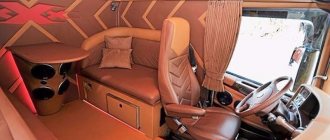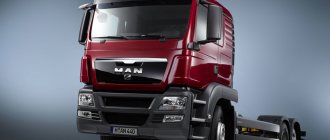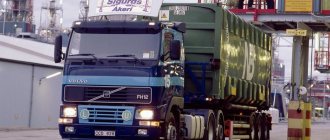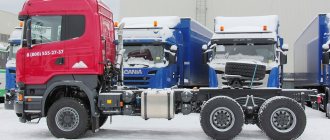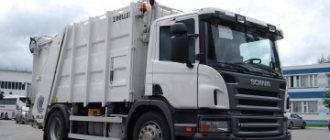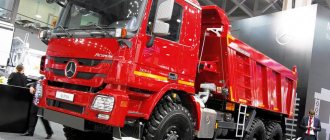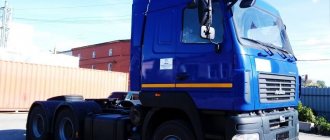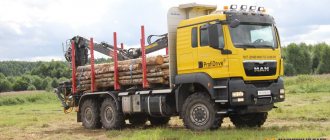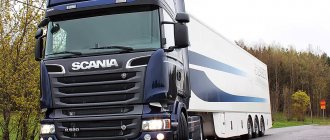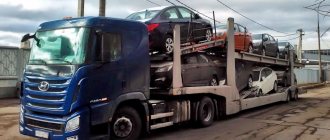| Manufacturer: | Scania-Peter LLC |
| Model: | Scania P440 B8x4HZ dump truck, Wielton body |
| Start of sales in Russia: | 2018 |
The subject of today's test is another representative of the large family of the new generation Scania.
In winter I went east on a standard road train with a 4x2 tractor, in early spring I tried out a specific Scania S620 A6x4NZ tractor, and now it was time to get to the dump truck. I got a nice hard worker with four axles (8x4), which never stumbled during several hours of persistent test drive torture. I tested the new generation Scania P440 B8x4HZ dump truck with a Wielton body for transporting non-metallic materials with a volume of 20 m 3 and a load capacity of up to 30 tons on various roads and calibrated slopes of the Dmitrovsky auto test site. I got a lot of adrenaline and positivity, but I need to figure out why.
Superstructure on frame
The designers were faced with a difficult task - to ensure high levels of technically permissible axle loads, and, as a result, load capacity, while they wanted to minimize the vehicle’s own weight. As a result of the calculations, we got a frame with side members measuring 270x90 mm, 9.5 mm thick with additional inserts 8 mm thick. The closing cross member of the frame is a rectangular profile with a wall thickness of 8 mm.
The design of the Wielton dump body with a bottom made of Hardox HB 450 steel 8 mm thick made it possible to reduce the dead weight of the superstructure without loss of strength; the thickness of the walls made of S700 steel is 6 mm. The front side is straight with a visor against shedding. The tailgate is inclined with forced fixation, an awning with a winch is provided, and we have not forgotten about the possibility of heating the body with exhaust gases. The HYVA Alfa hydraulic system is used on the dump body: the lifting angle of 48° is limited by a pneumatic valve. The temperature of the exhaust gases, according to the designers, is sufficient to heat the dump body, so they provided a splitter and a damper in the exhaust tract.
Link to the road
The transmission and chassis with two of the four drive axles are capable of withstanding fifty technically permissible tons at the back. Front steered axles with a load capacity of 9 tons each, on four-leaf parabolic springs, with anti-roll bars. Rear axles with a load capacity of 16 tons on multi-leaf springs 8x30/90. The final drives of the drive axles are made with helical gearing to reduce noise. All bridges are traditionally of our own production, originally from Sweden. The gear ratio of the main pair is 4.38.
A little about the brake system. Drum wheel brakes on all axles, a hill start assist system was not provided in this configuration, but a traction control system was included in the list of equipment.
Driving force with new injection
The test dump truck was equipped with an engine – a strong “average” engine of the new generation, but without any special frills. Meet the DC13 153 - in-line, six-cylinder, fifth environmental class with a power of 440 hp. at 1900 rpm, with a maximum torque of 2300 Nm in the range of 1000–1300 rpm. The inline six diesel engine of the fifth environmental class is equipped with a PDE injection system and an SCR exhaust gas aftertreatment system with synthetic urea injection. I will dwell on this fuel injection system in a little more detail. PDE unit injectors provide high pressure at the exact moment fuel is needed. The pressure in each cylinder is individually controlled. The situation is the same with pump injectors; pressure control during injection is carried out individually. Therefore, there is no need for a centralized high-pressure pump and a complex system of pipes to supply fuel to the injectors.
When problems occur, the problem will almost always occur in only one cylinder. With such an architecture, firstly, the car is able to move further on its own, albeit with a loss of power; secondly, testing and troubleshooting takes literally seconds. The process of neutralizing the exhaust gases of all “next-gen benches” is done without a recirculation system (EGR), only the latest EEC3 catalytic neutralization system is used, common for new generation cars of the fifth and sixth environmental classes. Its main difference is that now the nozzle sprays the AdBlue reagent under high pressure without first mixing air.
Big expense. All about SCANIA with HPI
- Go to page:
Sergey Ch.
- Quote
Post by Sergey Ch. » 03 Feb 2013, 00:03
Hi all. I already wrote on the forum about high fuel consumption. I checked everything that can be checked on the car, everything works well, but the overconsumption is haunting me at current fuel prices. And yet, at my office. services and here on the forum they confirmed that the pressure in the fuel system of 16 points is the norm. I suggest you watch a video on YouTube about cammins isx, unfortunately you can’t insert a link. On Scania the fuel is similar. At the very end of the video, the pressure in the fuel rail, after the fuel filter, is shown: 250 psi-17.7 points, when operating at idle and 310 psi-21.7 points at 2100 rpm. On my machine at 2000 rpm 17 points, that’s 240psi, at 1500 rpm 16 points before the filter, after the filter the pressure naturally drops by about 1 point? Moreover, the motor runs without load and the supply to the NF is minimal. Under loads when the car is loaded, fuel flows through the valves to the NF many times more than at idle, accordingly the pressure drops even more and there is no need to think about the correct advance. There is no correct advance and no traction, hence the high consumption. It turns out my fuel pump is dead. Guys, Power, who has the opportunity to measure the fuel pressure on a new car or on a car with normal consumption (20 tons-32 liters), I wonder what the indicators will be?
Power First stage Total messages: 150 Registered: 02/11/2010 Car: GAZ-2411, MTZ-09N, Scaldia-VolgaM24Break From: Moscow Region
- Quote
Post by Power » 03 Feb 2013, 10:24
Sergey Ch. , on new cars with HPI the pressure is even lower. Compared to episode 4. And it is 14 bar. 16 bar is normal. If it is not enough, there will be errors due to pressure. I suggest not comparing with Cummins, although it has the same design, it is quite obvious that the settings are different.
Added after 3 minutes 11 seconds: On Scania, the 21 bar safety valve will work. And there will be errors due to excess pressure, and when this happens, the unit immediately turns off the engine. Because the injectors are controlled by pressure, it can go wrong.
Sergey Ch.
- Quote
Post by Sergey Ch. » 03 Feb 2013, 13:07
Power, I believe you have access to such information, please answer the following questions: 1) What fuel pressure should be in my case, vin 5153514, engine dc 1214 l 01, car year 2006? 2) Does this book relate to my car? Here is an extract from the book from 2002. Cyclic fuel supply and injection advance The fuel pressure regulator maintains constant pressure in the fuel system. When the engine is running, the fuel pressure should be between 17-20 bar. The electronic fuel supply control system EDC (Electronic Diesel Control) regulates the cyclic fuel supply, as well as the advance of fuel injection into the engine cylinders. The fuel for injection into the cylinders and the fuel for regulating the injection timing entering the unit injectors are dosed by solenoid valves. Two solenoid valves dose cyclic fuel supply and two solenoid valves dose fuel to regulate injection timing - one solenoid valve of each type for the corresponding injector block. The duration of the control pulse (i.e., the duration of the open state of the solenoid valve) determines the volume of fuel entering the pump injector. The fuel pressure is maintained constant and the duration of the phase is adjustable. The duration of the control pulse is set by the EDC control unit. The control unit acts as the brain of the EDC system. The control unit processes signals both from sensors and devices included in the EDC system, as well as data received from control units of other vehicle systems. After processing the received data, the EDC unit issues control signals to the solenoid valves, which in turn regulate the amount of fuel entering the pump injectors.
Housing is not just for work
Climbing high into the cab of a dump truck will make you jump in a day! Inside, I was greeted by a more modest dashboard compared to previously tested tractors, but with the already favorite scales, with calm, smooth lines and contours, but not such large and colorful displays. You can’t find fault with the finishing materials, but of course there is no such space as in a mainline tractor, especially vertically, and the engine tunnel makes its presence known in an important way.
But even despite the low ceiling, you can sit comfortably; the door opens at a right angle, without interfering with boarding the cabin. For hard work in a dusty quarry, climate control is provided, and the space behind the seats is practical with convenient lockable storage compartments. Wow, you can take a nap on the folding shelf in this compact cabin. Swedish, that is, real, socialism!
Among the comfortable equipment, I also found electric windows with closers, a sunroof, adjustable rigidity of the mechanical cabin suspension, cruise control, an audio system and an autonomous heater with a power of 3 kW. Thumbs up! It’s not clear why they were “greedy” on the armrest of the driver’s seat; apparently, they decided so because of the simple manual gearbox.
I adjust the seat, secure the steering column with a pneumatic lock, quickly look through the gear shift algorithm on the knob, turn on first and slowly roll out onto the smooth asphalt. Again, I would like to praise the excellent ergonomics, where the driver’s workplace is shifted forward and to the left, and the instrument panel is lowered down. In principle, there are no fundamental differences in the cabin from its mainline relatives, but it is closer. I repeat, the cabin suspension here is mechanical, on springs, with the ability to adjust the stiffness.
Subtleties of gear selection
The body is partially loaded with sand: 6 “cubes” of approximately 1600 kg each, which comes out to somewhere around 10 tons, adjusted for humidity. This is approximately half of the rated load capacity; in principle, it is enough to understand the process. A manual gearbox with “12+2” gears operates with three lever strokes. The mechanics showed the need for a short adaptation for the driver. Firstly, there is a slightly different algorithm than the widely used “old” ZF 12-mortar. The first (fourth) gear is engaged by moving the lever back, the second (fifth) to the right and forward, the third (sixth) to the right and back. In addition, the cable drive slightly blurs the clear boundaries of the gear selection zones.
On dry asphalt with a partial load, you can easily start moving from II, then select the top row with the “Adam’s apple” of the range, while at the same time substituting the lower “half” of IV gear with the nose of the divider, then, having accelerated a little, we move to higher ones. In this range, somewhere after 45 km/h, the “halves” almost no longer play any role. If the switching time is delayed out of habit, and the gear that entered late turns out to be too high, there is no need to be scared and fuss - the engine confidently pulls out already from 700–800 rpm, but this should not be abused: load, increased consumption, and the on-board electronic “teacher” » will reduce the star rating for driving by coloring yellow on the display not all five stars of the scoring system for assessing driving skill.
Cost of installation and equipment © Transmission system
| Scania 93 M/280 / Scania 3-series, 2-engine chassis, 282 l. s, manual transmission, 1988 - 1996 - increased fuel consumption per km, however, recently Scania has been professing the on-demand principle, when the need for an oil change is determined based on actual operating conditions. If you're leaving in your own backyard or in a parking lot that has a power line, simply plug an extension cord into the electrical socket. |
| 12 driving tips to become a true master of fuel economy Thanks to masters like Kizilkaya, in six years of work, laboratory specialists have achieved impressive results - a significant reduction in fuel costs and a reduction in their own carbon dioxide emissions by 50. Scania Fuel Masters Europe is an interactive competition, participants who compare their most economical trips with the results of other drivers using a mobile phone. |
Use an engine heater • The driver has a comfortable interior.
A long straight paving stone and a narrow corridor
Having completely gotten used to the new gearbox, I leave the asphalt and go onto the cobblestones with rough paving. And I understand that, just like in the winter test, the Scania S620 A6x4NZ construction tractor does not shake at all, even despite the springs on all four axles and the simple spring cab suspension. After the paving stones, I dive into a narrow dirt break to change the route to the mountain one. On the right is a hole almost as deep as a wheel, the width of the corridor is no more than three meters. I take it wider and the first time I find myself in a narrow technological corridor on a relatively long four-axle machine. Conclusion: the creators were able to achieve a large angle of rotation of the steering wheels. Previously, on such a dump truck, in order to fit in, I would definitely have had to use reverse, even if just a little.
Mother-in-law's tongue is on edge
Now a series of slopes combined with curves in the plan - an imitation of a mountain serpentine. The main topic is downhill speed control. For the driver of the new Scania, everything is indecently simple, even somehow not “truck-like”. There is no need to fussily switch the retarder positions to achieve stable deceleration. The electronics will independently select the tools to hold a loaded dump truck on a slope. The car itself will provide a steady deceleration; I only need to fix the desired speed at the right moment on a descent by briefly lightly pressing the brake pedal, and after pressing the gas, the function automatically turns off.
Here, in general terms, is my short report about the next representative of Scania. In conclusion, I just want to draw your attention to the fact that the technical capabilities of the Scania P440 B8x4HZ dump truck exceed some of the requirements for axle loads for public roads, therefore the truck should be loaded with all its heart and effort in quarries and driven on industrial roads, so as not to conflict with the law...
Scania is reliable in any circumstances
When driving a vehicle on terrain with a steep relief, the optimal speed limit will be 43 kilometers per hour, while the consumption of flammable substances will be 144 liters per hundred kilometers of terrain. The difference in the size of the cabins of these two series is only in the height of the podium in the middle, that is, the tunnel above the engine at the bay window is 160 mm lower, and in the inaccessibility of the Topline cabin for the G-series, which has an internal height of 2230 mm.
Secrets of the new model tires
New generation Scania equipment is equipped with MICHELIN tires; one of the most used tire models is the X Multi line. The molds for this rubber are made using new 3D printing technology. It allows the formation of self-renewing tread blocks, including hidden sipes that open as they wear. It is these hidden sipes that ensure optimal levels of grip and safety in all weather conditions throughout the life of the tyre.
Manufacturer: Scania
| Tank, l | 300+300 |
| Engine | 440, Euro-4 |
| checkpoint | 16-speed |
| Cabin | 1 bed |
| Wheel formula | 6X4 |
| Saddle load, kg | 26 000 |
| Suspension | Springs |
| State | New |
| Year of issue | 2019 |
| SSU height | 1 330 |
Truck tractors from the Swedish company Scania are very popular in the domestic market due to their impeccable quality, increased cross-country ability, road safety and reliable chassis. Scania P440 CA6x4HSZ Truck tractor designed for regional freight transportation on public roads. It is equipped with a reinforced frame with double side members, a stabilizer on the front axle, air suspension, a turbocharged diesel engine, drum brakes, an air dryer, three hundred liter aluminum fuel tanks, a heated fuel moisture separator and a fuel heater. The truck tractor with a 6x4 wheel arrangement is equipped with a comfortable cabin with one berth, a drawer, central locking, and electrically heated and adjustable mirrors. As standard, the Scania tractor has air conditioning, climate control, an autonomous cabin heater, and an adjustable steering wheel.
Scania P440 CA6x4HSZ Truck tractor is certified and made in compliance with all the necessary requirements that apply to cargo transport of this type. Truck tractors of the Swedish brand undergo mandatory testing before sale in the factory and the strictest quality control at all stages of the production process. There is a well-developed dealer network on the territory of the Russian Federation, allowing consumers to purchase Scania tractors anywhere in the country. In authorized service centers, you can timely and efficiently repair and replace spare parts for Swedish-made trucks. The trucks of this manufacturer are perfectly adapted for operation on Russian roads. It will solve any transport problem. Scania tractors are designed specifically for the domestic transport market. They are able to provide maximum performance and long service life. Scania truck tractors have been repeatedly awarded the “Best Foreign Truck of the Year in Russia” award.
DESCRIPTION OF STANDARD EQUIPMENT:
Reliability and high level of comfort on a long journey
Scania R440 is a family of truck tractors designed for long-distance transportation. In the basic version, the car is presented in a two-axle design, with a 4x2 wheel arrangement. However, if necessary, three-axle versions are also produced under the same factory designation. For example, Scania R440 LB6x2HLB. They are adapted to more severe operating conditions and are designed to solve specific problems. In general, even in the two-axle version, the frame and chassis of this tractor do an excellent job of transporting heavy loads over long distances.
Operating the P400 Dump Truck
Scania P400 is a large-capacity dump truck, especially popular in Russia. It features a 6x4 wheel arrangement, which allows the vehicle to transport a wide range of different materials over long distances.
The Scania vehicle is suitable for use on roads of any category and in field conditions. That is why it is especially popular in rural areas. The dump truck copes well with its functions in all road and weather conditions, which corresponds to the real situation in most populated areas of the country. Most often they are used in agriculture, industry, municipal services, and road construction.
Scania P400 dump trucks have proven their efficiency and reliability in the most extreme operating conditions. Their enormous popularity is explained by the following features:
- the presence of a diesel engine with optimal power that operates reliably at any speed;
- excellent maneuverability;
- unpretentiousness of the car in any operating conditions;
- the presence of a durable frame and a spacious body, which ensures the transportation of various cargoes.
Scania P400 - dimensions and technical capabilities
Model features
This car does not belong to economy class. Its cost is quite high even for large transport organizations, not to mention ordinary carrier entrepreneurs. However, this is compensated by high rationality in use and cost-effectiveness in maintenance. An important role is also played by the highest comfort for the driver, which is the signature style of the automaker.
Everything in the cabin of this long-distance truck contributes to the comfort and well-being of the driver working in long-distance transport conditions. Standard equipment in the cabin of a Scania R440 class vehicle includes an on-board computer, an audio system, climate control, two spacious and comfortable berths; provides for the placement of a full-fledged coffee maker and a refrigerator with a freezer.
And the Scania R440 tractor is absolutely universal; in the rhythm of continuous operation it performs any transport tasks, standard and specialized: long-distance cargo transportation, including international; Suitable for various types of semi-trailers: tent, isothermal, refrigerated.
Among the characteristic family features of these machines are exceptional driving comfort, a perfectly functioning braking system, perfectly adjusted power, allowing you to make long climbs without the slightest, even when loaded. Among the important advantages of the technical equipment of this car is the presence of suspension height adjustment.
Ideal for short distances
The first group, “P”, is vehicles for those who need to solve the problems of transporting goods over short distances every day. Here you can choose among models in five formats. These are three long cabins, one short and a format without a place to rest. These trucks are ideal for working in urban environments.
The Scania truck tractor from the G series is a cabin with additional storage compartments that may be useful on the road. Trucks in this series are distinguished by an increased level of comfort and a powerful engine. These tractors work well in long-distance cargo transportation.
Frame, suspension and chassis
The Scania R440 is based on a reinforced, heavy-duty spar (ladder) type frame, supported by four-point air suspension. The front axle of the car is equipped with a dependent architectural structure, on parabolic springs and with a transverse stabilizer. The rear axle of the truck tractor is equipped with a 2-cylinder air suspension. And on three-axle versions of this truck tractor, a balancer suspension is most often used at the rear. On the second axle (and on the third, too, when there is one) there is a gable tire.
Even more comfort and power. Scania p440la4x2hna
| Scania truck tractor: technical characteristics, fuel consumption and reviews Since Scania classifies its trucks by cab type, the name R440 implies that these truck tractors are equipped with the flagship R-type cabs, the most spacious and with the richest equipment. Scania P8X400 vehicles, whose technical characteristics differ significantly from conventional vehicles with an unloading installation, have a unique frame structure on which 4 axles are located, 2 of which are driving. |
Technical characteristics of the Scania R440 chassis
- Frame spars: F950, 27О x 9О x 9.5 mm.
- The largest load on the front axle is 7.5 tons.
- The largest load on the rear axle is 11.5 tons.
- Wheelbase - 3.7 meters.
- Parabolic springs of the front suspension – 3×29.
- The wheel size on the front and rear axles is the same - 9.0 x 22.5 inches.
- Tire size on both axles is 315/70 R22.5.
- Fifth wheel coupling – J0ST JSKЗ7C-Z 15О.
- Fifth wheel mounting plate – 22 mm, D-value max 152kN
- The position of the fifth wheel coupling is 66О mm.
- The height of the fifth wheel coupling is 115О mm. Heated fuel filter-moisture separator Rear-facing exhaust pipe
Steering and brake control
The truck is equipped with a modern progressive hydraulic power steering system. The brake system of the Scania R440 tractor is equipped with electronic control (EBS) and an anti-lock braking system as standard. The brake mechanisms are disc (on newer cars) and drum type (on cars of previous years of production). Parking brake control lever – with test position.
Scania R440 car design
Over the course of many years of serial production, Scania R440 truck tractors have not remained unchanged, periodically experiencing another facelift. But somehow they managed to preserve the corporate style during the process of these transformations. The front side of the tractor cab still stands out on the highway with its huge and long radiator grille, divided into six sections.
In keeping with Scanian tradition, the trucks are equipped with a retractable/folding “bench” at the bottom of the radiator grille. It is convenient to stand on it with both feet in order to properly clean the windshield. The massive bumper integrates rectangular headlights with two round sidelights.
The Scania R440 cabin has excellent aerodynamics, which contributes to lower diesel fuel consumption at high speeds on country roads. There is a visor above the top of the windshield, which effectively protects the driver from the sun.
The side styling of the cabin is complemented by small embossed lines, which also belong to the signature design of this automaker. It is convenient to get into the cabin, going up two massive and wide steps. The doors have fairly large double rear-view mirrors, which practically eliminate blind spots for the driver.
The list of external equipment for the cabin type CR19H (high) of the Scania R440 truck tractor includes headlights (including fog lights) with headlight cleaners; head lamps – gas discharge (xenon); additional high beam headlights in the bumper; step lighting lamps; orange road train sign with switch. The tractor cab suspension is pneumatic, at four points. The cabin stabilizer is of normal rigidity. The sunroof is electrically controlled from the driver's workplace and from his berth.
External equipment
Cab model CP14L, Low Off-Road Cab suspension Mechanical at 4 points Road train sign Without road train sign Rear view mirrors Manually adjusted and heated Rotating beacons on the cab roof Prepared for installation Sunroof Manually operatedEngine Scania R440
The Scania R440 truck tractor is equipped with a diesel engine model DC1З 1О2. This is a six-cylinder in-line engine equipped with a turbocharger with intercooling of charge air and an electronically controlled/regulated direct diesel injection system. The working volume is 12.7 liters.
The power of the DC1Z 1O2 diesel engine is 440 horsepower (or 324 kW), at 1900 rpm. The environmental standard of these engines is at the level of Euro-4 (SCR) - in cars produced in the 2000s / Euro-5 (SCR) - in trucks produced in the 2010s. The highest torque is 24OO N.m, at 1OOO-1ZOO rpm. The power unit is equipped with an engine brake with automatic and manual control.
If DC1Z 1O2 engines are supplemented with an SCR urea injection system, then compliance with Euro‑4 standards, which is relevant for our country, is obtained, and if they come with an increase in the AdBlue injection dose, then compliance with Euro‑5 European standards. When the DC13 is equipped with a Common Rail electronic injection system, a VGT turbine and EGR recirculation technology, it is again compliant with Euro 5. But so far in the Russian Federation only those automobile enterprises that are engaged in regular international transportation - between Russia and Europe - are concerned with Euro-5 standards.
The car's maximum speed is electronically limited to 90 km/h. As a standard, the truck tractor is equipped with two aluminum fuel tanks with a total volume of 1100 liters (600 liters on the left, 500 liters on the right). Diesel fuel consumption on the road depends on the load level, terrain features and driving style, and averages from 28 to 38 liters of diesel fuel per 100 kilometers.
The Scania company adheres to the principle of maximum possible unification of components and assemblies in production. For example, diesel engines of different volume and design are largely unified among themselves in terms of piston, separate heads, connecting rods and crankshaft liners. There is also widespread unification in gearboxes.
Transmission
The engine is connected to the gearbox using a single-disc clutch with a wear protection system. The gearbox is installed on the GRS905 . This is a 12+2-speed manual transmission with a range and divider, with two reduction gears and two reverse gears. Its design uses a special Opticruise automatic gear shift system. It allows you to use the clutch only when starting (pushing the car away). While driving, you do not need to press the clutch to change from one gear to another. When changing gears, the minimum effort required is required, which is the main goal of all Scania innovative developments, which are ultimately aimed at improving the driver's working conditions.
The GRS905 gearbox is designed for significant engine torque, it has forced oil cooling - a heat exchanger with its own fan is mounted on the frame. A hydraulic transmission retarder - R41OO retarder - can also be installed at the gearbox. It helps to brake well on long and steep descents of the road, without smoking the pads. The maximum braking torque absorbed during this braking is 4100 Nm, and the maximum short-term output power is 500 kW. The main drive model of the tractor is R780. It is single-stage, hypoid type. There is also a differential lock system on the drive axle. The main gear ratio is 1:2.92.
Scania is one of the few auto manufacturing companies that for many years has independently produced not only manual transmissions, but also automatic transmissions based on them (since 1994).
Unlike similar gearboxes from other manufacturers, the electro-pneumatically controlled switching mechanism here is installed on a standard mechanical box - accordingly, there are no special housings, shafts and gears, even standard synchronizers are retained.
The new Economy mode of Scania Opticruise gearboxes is integrated into the cruise control system, and this solution can actually save up to five percent of diesel fuel on the road.
Scania Mining G440 8×4 mining dump truck
SCANIA G440 CB8x4EHZ dump truck with a body for rocks, belongs to a series of high-performance quarry-type vehicles of the Mining division, used as multi-purpose self-propelled rock transporters in open-pit mining, in closed mining (tunnel construction) and as a universal earth hauler and metallurgical dump truck . The Scania dump truck uses a four-axle chassis with an 8x4 wheel arrangement and a reinforced frame and wheel axles. The multi-axle chassis made it possible to keep the road dimensions of the vehicle within acceptable limits, which allows the use of a quarry dump truck in overburden mining operations of a large area, with the ability to work on a large shoulder, as an earth hauler and ore carrier in shallow mining. The Scania dump truck body is designed for loading by hydraulic and cable excavators and heavy front loaders with a bucket or shovel volume of no more than 5 cubic meters. The dump truck, despite its similarity with conventional road dumpers, has major differences in design; first of all, it is a dual powerful frame designed for a load of 60 tons, wheel axles with onboard planetary gearboxes and a high degree of reduction on a leaf spring suspension. The dump truck engine develops 440 hp. (324 kW) and significant torque of 2300 Nm at 1000-1300 rpm. The dump truck is equipped with a reliable mechanical transmission with a 14-speed GRSO925R gearbox, with the Scania Opticruise automatic gear shift system.
The main element of the Scania mining dump truck is the body, designed for heavy work with large-lump loosened mass of granite and basal rocks, and therefore has high strength and abrasion protection. The dump truck is equipped with a body manufactured by KH-Kipper with a volume of 24 cubic meters, with Hyva hydraulics. The dump truck has a powerful quarry-type reinforced rib structure of increased rigidity, without a tailgate, but with a bevel to protect against spillage. To protect the driver's cab, a FOPS canopy is provided over the cab. The body material is high-quality Swedish steel Hardox 450, resistant to wear when loading, transporting and unloading abrasive materials. The thickness of the underbody is 12mm plus the bottom layer is 8mm, the side sheet uses a thickness of 8mm.
Detailed Specifications
Technical description of the dump truck
Purpose of the dump body: the body of the dump platform for the automobile chassis is designed for transporting minerals of high density and hardness, including rocks with a stone size of no more than 1,500 mm in diameter. Therefore, the body does not have a heating system and a tailgate.
rearward, with front-mounted telescopic hydraulic lift and stabilizer linkage to neutralize lateral forces
Welded, box-section, with developed stiffeners
multilayer, combined with the use of shock-absorbing rubber between layers of steel
FOPS-ROPS driver cabin protection system
using a welded canopy in a single design with a dump body
Type of wheeled chassis: special wheeled multi-axle all-terrain chassis designed for installation of dumping equipment, and performing traction and towing operations in extreme rough terrain conditions. Chassis with a reinforced design of the Heavy Duty series for severe operating conditions, with the ability to couple with trailed equipment. The chassis has a special frame and wheel axles designed for large tires with high load capacity.
Truck cab Scania R440
This model is distinguished by an exceptionally comfortable and functional cabin, almost ideal for a long-haul truck tractor. Many truck drivers rightfully consider the interior of Scania truck cabs to be one of the most attractive workplaces in the world. The interior space of the cabin is distinguished by precise ergonomics, very high-quality finishing materials and functionality in everything. This is a true comfort zone.
The ceiling height, if calculated from the floor level in the center of the cabin, reaches more than 2 meters 20 centimeters in the high cabin version and provides excellent internal comfort. An exceptionally comfortable driver's seat and an impressive level of equipment turn the Scania cabin into a full-fledged home on wheels, which is especially important on long, multi-day intercity and international flights.
The seat can be easily folded, turning it into a table. There is a special plug that can be connected to an outlet or other current source equal to 220V, and thereby warm up the engine before starting it in cold weather. The driver's seat as standard on a tractor unit is premium, air-sprung, and electrically heated. The instrument panel is long, made of high-quality plastic. The instrument cluster is complemented by a “Color plus” color display. The steering wheel is trimmed in brown leather. The front panel on the passenger side has a document tray plus a table.
The total width of the lower berth is variable, it is 7OO-9OO mm. The total width of the upper berth is constant, it is equal to 7OO mm. There are storage spaces on the left side walls of the cab. The doors have convenient pockets with special holders for bottles of soft drinks.
The basic cabin is equipped with central locking with remote control, air conditioning, an autonomous “dry” cabin heater of 4 kW, and a modern premium radio. The installation of a standard tachograph device is provided, as well as an additional telematics system FMS - the “Monitoring” package to optimize the work of serious transport companies.
The fleet management system (FMS) and advanced service solutions help to download vehicle diagnostic data in remote access mode, thereby maximizing the useful time of the vehicle and minimizing the time it takes to visit the automaker's dealer service center.
Cabin interior
The cabin is made of high-quality steel, there is no hood arrangement. The salon is designed for two people. It contains a computer with an interface in Russian and a one-day tachograph. The computer transmits sensor data to the driver. In principle, the car control panel is accessible and convenient to use.
The operator's seat is ergonomic. It can operate in 10 modes. The seat is mounted on air suspension. The driver of the Scania P380, if necessary, can activate the seat heating, adjusting the heating system if desired. The passenger seat can be unfolded or folded at any time.
The cabin is made according to all standards, its design has many positive aspects:
- Safety. It is responsible for high-rigidity stabilizers, anti-lock design, and a suspension with four blocks. All this is very important;
- Optimal clearance. It is provided by external wide-angle near mirrors, heated rear mirrors;
- Operator comfort. You can easily adjust the power steering. At the exit there are mats made of a safe material - rubber. There are handrails, a sunroof;
- In addition to driver safety, there are standard warning triangles, a first aid kit, a fire extinguisher, a storage box, a connector for a music system, and a flashing light.
Under the radiator trim there is a lever for raising the cab. During maintenance, the driver will not experience any inconvenience.
Interestingly, not all Scania P380 drivers feel comfortable driving a Scania. But most likely it's their fault. After all, modern technology can be completely customized to suit you. A properly adjusted chair is the path to comfort.
To set up the chair, you need to follow the step-by-step instructions:
- Adjust the chair height. The pillow should be close to the hips;
- Adjust the recline of the chair. The hip should receive balanced support along the entire length of the chair cushion;
- Adjust the depth of the floor in relation to the back. The space in the cavity should be the size of a fist;
- Adjust the backrest tilt – 100-110 degrees;
- Lumbar back support is adjustable using buttons;
- The seat can be moved forward or backward for complete comfort;
- The steering wheel should be positioned so that the operator's arms are slightly bent at the elbows and shoulders down.
So you need to take care of yourself. This issue must be approached with full responsibility.
Other technical characteristics in numbers
- Overall dimensions of the truck tractor: length – 5.96 m, width – 2.5 m, height – 4 meters;
- Wheelbase – 3.75 m;
- The lowest ground clearance is 265 mm;
- The front track width is 2.034 m, the rear track width is 1.83 m.
- Rear overhang – 3.6 m.
- The tractor's curb weight is 8.7 tons, maximum weight is 19 kg. The total weight of the road train (including the semi-trailer) is up to 40 tons.
- Rechargeable batteries – 225 Ah, generator – 1OOA.
- Capacity of aluminum fuel tanks: left – 600 liters, right – 500 liters. The capacity of the aluminum tank for urea is 75 Dm3.
Cost of Scania R440 tractor, new and used
Scania truck tractors occupy one of the first places in terms of stable demand in the secondary market. This is due to the high price of new vehicles and the impeccable reputation of Scania trucks as having an exceptionally high safety margin, originally laid down by the manufacturer. The price of the new Scania R440 truck tractor starts at 6 million 500 thousand rubles. The choice of these trucks on the secondary automobile market is very large, as is the range of prices that sellers want to get for them. Depending on the year of manufacture and technical condition, for a used Scania R440 tractor they ask from 1.8 million to 5 million rubles.
In general, Scania R-series truck tractors are traditionally one of the most common models of long-haul tractors in Russia. According to the analytical agency Autostat, currently the number of Scania R-series highway vehicles in the Russian Federation has exceeded 30 thousand vehicles. More than half of them were imported from the secondary market in Europe, and over the past years many have been sold again in Russia to new owners. Scania “intermediate” G-series tractors are also common. They are noticeably cheaper than R series cars, but are also quite comfortable for our brother on long flights. Therefore, there are much more G-series vehicles than the flagship R. By region, most of Scania tractors are registered in the Central and North-Western districts, and there are also many of these trucks in the Volga region.
SCANIA HPI: 25.8 l/100km - HOW to achieve such fuel consumption
Please Login or Register to join the conversation.
Less - more
- Posts: 1
- Thanks received: 0
1 year 8 months back #112 from yral203 yral203 replied to the topic SCANIA HPI: 25.8 l/100km - HOW to achieve such fuel consumption
Hello, how much has fuel consumption decreased? I have the same Scania, I haul 24 tons, consumption is 39-40, if I do the same as in the video it will help reduce consumption?) because sometimes the fuel consumption readings are completely different than on the computer and in reality .
Please Login or Register to join the conversation.
Less - more
- Posts: 1
- Thanks received: 1
1 year 8 months back #113 by Roman230881 Roman230881 replied to the topic SCANIA HPI: 25.8 l/100km - HOW to achieve such fuel consumption
Good afternoon Where can you do the same? Same symptoms, smoke and vibration. If anyone knows, please tell me. VIN code, 2041989
Thanks said: admin
Please Login or Register to join the conversation.
Less - more
- Posts: 555
- Thanks received: 14
1 year 8 months back #114 by admin admin replied to the topic SCANIA HPI: 25.8 l/100km - HOW to achieve such fuel consumption
Hello. The PDE has the same sensor and is responsible for the same thing. Therefore, it can be done, but you need to know what your boost sensor shows. And in general, start with diagnostics.
Please Login or Register to join the conversation.
Less - more
- Posts: 1
- Thanks received: 1
1 year 8 months ago #115 from Andry Andry replied to the topic SCANIA HPI: 25.8 l/100km - HOW to achieve such fuel consumption and specific photos/videos can be taken from the sensor. Thanks said: admin
Please Login or Register to join the conversation.
Less - more
- Posts: 555
- Thanks received: 14
1 year 8 months back #116 by admin admin replied to the topic SCANIA HPI: 25.8 l/100km - HOW to achieve such fuel consumption
On the sensor connector, I cleaned the third contact (labeled there), soldered one end of the wire to it, and secured the other to the control unit mounting bolt.
